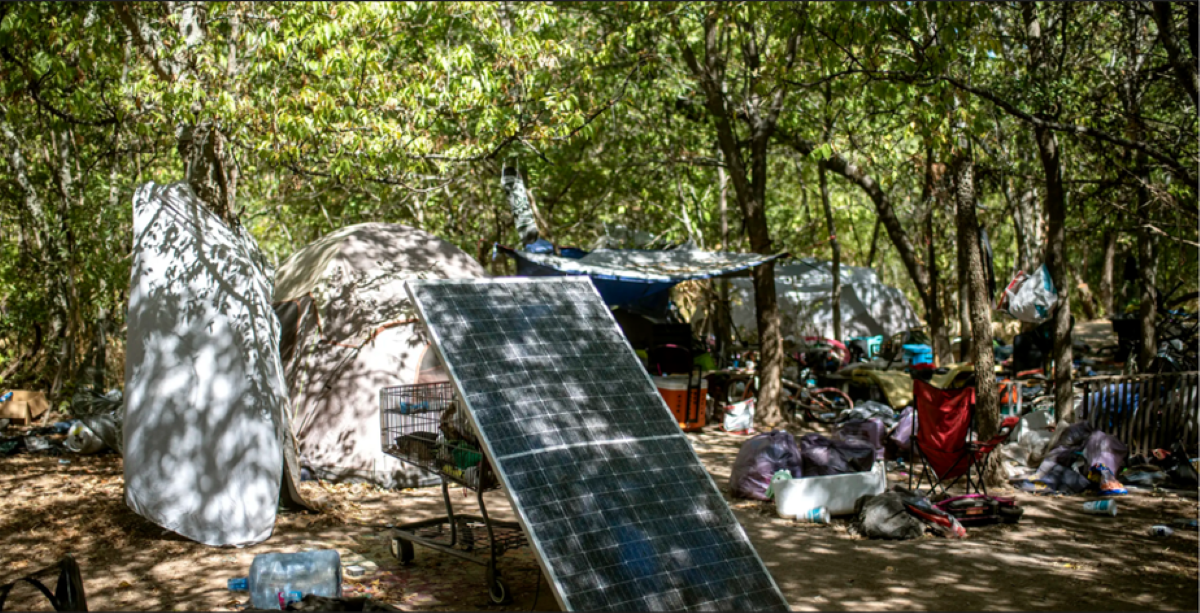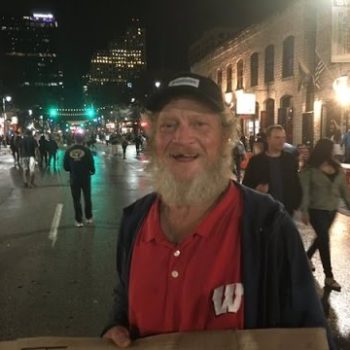This article was first published at Texastribune.org:
Police Have Had to Eject Hundreds of People from Encampments. They Still Struggle to Tell Many of Them Where to Go.
Early one morning in mid-August, police officers and cleanup crews met at Roy G. Guerrero Park in East Austin, where dozens of people have lived in tents and under tarps among the trees for months. Police and public health workers maneuvered ATVs along dirt trails, reminding people living there that they would have to leave soon.
Greg McCormack, a program manager for a city initiative that has moved dozens of people from the park and other encampments into shelter and eventually into housing, made the rounds. He knew there were not enough shelter beds for everyone there.
“We’re clearing this area soon,” McCormack said, approaching a man who was sitting outside his tent in a small clearing. The man was a recent arrival to the encampment. He asked McCormack where he was supposed to go.
“I don’t know,” McCormack told him. “If you’re new here, we won’t be able to help you with housing.”
The encampment, hidden from view by the dense tree and shrub cover of the park, had become a small community, with makeshift living rooms furnished with couches, rugs, mirrors and dressers. As police and city workers have cleared other homeless encampments from downtown sidewalks and nearby parks, this one grew to around 150 people — one of the biggest that city agencies have seen yet.
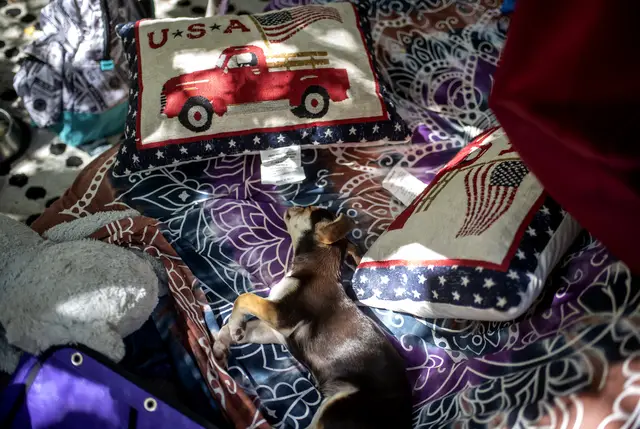
A puppy sleeps on a sofa at the encampment in Guerrero Park. Credit: Sergio Flores for The Texas Tribune
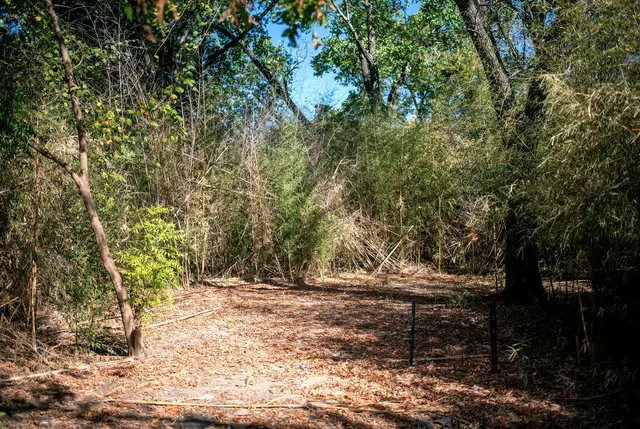
An area of the encampment had been cleared by Aug. 18. Credit: Sergio Flores for The Texas Tribune
For the past year, police and other city agencies have been enforcing the public camping ban that Austin voters reinstated in a May 2021 ballot measure. But with too few shelter and housing slots — and only one legal place to camp — homelessness in Austin has grown by about 20% in the last year while people living on the street have been pushed farther into the shadows.
At the same time, Austin has committed hundreds of millions of dollars to creating more housing for its homeless population, which is slowly becoming available. The city has converted two former hotels into shelters that can house up to 130 people as encampments are cleared and has plans to add more than 1,000 more housing units in the next two years.
But for now, people living on the street continue to be shuffled from place to place, and the police clearing the camps often have nowhere to send them.
“If someone says, ‘I want to come into compliance, where do I go?’ We have no answer,” said Lt. Lawrence Davis, who leads the Austin Police Department’s camping ban enforcement.
Three years ago, Austin’s City Council ended the city’s 23-year-old ban on public camping, an effort to decriminalize homelessness. No longer fearing tickets or arrests, people soon set up tents on sidewalks, under highways and in public parks, changing the landscape of downtown and making homelessness far more visible.
Residents and downtown business owners protested the decision, arguing that it had allowed homelessness to swell out of control. Meanwhile, Gov. Greg Abbott blasted Austin’s leadership and sent Texas Department of Transportation workers to clear encampments from under highway overpasses.
A political action committee called Save Austin Now gathered enough signatures to put a camping ban on the ballot, which Austin voters overwhelmingly approved by a 57% to 42% margin.
The new ordinance, called Proposition B, made lying down or camping on public property a misdemeanor punishable by a fine of up to $500. The following month, Abbott also signed into law a statewide camping ban passed by the Legislature, with penalties for any city that failed to enforce it.
With that, Austin’s brief experiment with decriminalizing homelessness ended, and it became one police officer’s job to figure out how to reverse course.
“Homelessness is not a law enforcement issue”
Shortly before Proposition B’s passage, Davis, an 18-year Austin police veteran, got a promotion and a new assignment: to lead the enforcement of the revived camping ban. There was immense pressure to fix what felt like a local crisis.
He gathered some of his officers in a conference room to come up with a plan. More than 2,000 people lived on the street at the time, many of whom were now in violation of the law. About 30 officers were assigned to the task, in addition to their other duties, a number that has since dwindled to around 20.
One big question hung over their discussion: Where would they tell people to go?
“That kind of weighed on everyone’s heart,” Davis said. “If we’re going to tell people to leave, then it just seemed reasonable that we should be able to tell people where to go.”
The same question has troubled other Texas cities. In 2017, a federal judge ordered Houston to temporarily stop enforcing its camping ban because its shelters were full. The judge wrote that enforcing the ordinance when people had nowhere else to go would violate their Eighth Amendment right to be free from cruel and unusual punishment.
Davis and the officers eased into enforcement, visiting encampments and telling people that the law had changed and they would soon be asked to leave. They didn’t issue tickets in the first month.
At the time, the city was debating opening sanctioned encampments where people could legally camp, which Davis thought could help alleviate his dilemma.
But the city’s efforts on that front quickly stalled. After identifying 78 potential properties, city staff whittled the list down to two that met certain criteria — like size and proximity to public transportation and grocery stores — by July 2021.
The plan died after opposition from residents and council members who argued that it wouldn’t solve the bigger problem and the city should focus on creating more permanent housing.
Austin does have one sanctioned encampment, opened on state property by Abbott in late 2019 at the height of his verbal war with city leaders. The site, on a previously vacant Texas Department of Transportation parking lot, was run by state troopers before a nonprofit called The Other Ones Foundation took over in August 2020.
Around 150 people live there now, and the organization is in the process of installing 200 individual emergency shelter units — tiny huts that offer more protection than a tent but are not meant for permanent housing. For now, the site is full.

A sanctioned encampment at a former Texas Department of Transportation facility on Jan. 23, 2020. The state established the site for people experiencing homelessness in Austin after Gov. Greg Abbott criticized city leaders for not doing more to remove encampments from public spaces. Credit: Eddie Gaspar/The Texas Tribune
By mid-June, Davis and his officers began asking people to move willingly or face a ticket or arrest. He said most people move after a warning and officers don’t issue tickets as a first resort.
Since Proposition B passed, 325 citations have been issued — far fewer than in previous years. Still, a person living on the street likely cannot afford the fine, and most of the time people do not show up in court, which leads to arrest warrants and criminal histories that make it even harder to find housing and employment.
Davis said his officers have sometimes been reluctant to take on this responsibility.
“One of the great difficulties is homelessness is not a law enforcement issue,” he said. “I spend a lot of my time convincing my officers we can do this.”
More than 10 city departments have played a role in moving or cleaning up encampments. According to a May report by the city’s Homeless Strategy Division, the city “services” more than 68 homeless encampments each month on average.
New camps often form near closed ones. In February, police cleared an encampment of more than 30 people at Longhorn Shores, a park along Lady Bird Lake in East Austin.
The Parks and Recreation Department wrote in an operations plan obtained by The Texas Tribune that because shelters and housing programs were full, none of the people in the camp would be offered shelter during the cleanup, which would cost an estimated $30,000 and would likely push people “only a short distance from the current encampment.”
That’s exactly what happened. Many people, some of whom had relocated several times already, picked up their belongings and walked across Pleasant Valley Road and into the woods of Guerrero Park.
“Roy G. Guerrero is the last stop,” Davis said. “People have run out of places to go. The elephant in the room is the same as when we started.”
Austin Investing in More Housing
In Austin, most people living on the street or in shelters have already been assessed for housing and are on a waiting list that averages about eight months. The majority of housing programs for people coming out of homelessness in Austin have relied on private landlords who will accept housing vouchers, which has become increasingly difficult in the city’s tight rental market.
Rents in Austin have increased 40% in the past year — more than any other metro area in the country and nearly three times the national average — according to Redfin data. As a result, people are falling into homelessness at a much faster rate than the city can house them.
But there is some light ahead.
A month before Proposition B passed, Mayor Steve Adler organized a summit with city officials and community leaders to come up with a plan to address the growing number of people living on the street.
The group set a goal to house 3,000 additional people — on top of the roughly 1,700 the city houses each year now — by creating 1,300 new permanent housing units and using landlord incentives to secure another 2,000 units in the private market by the end of 2024.
They set a $515 million goal for the ambitious effort, called Finding Home ATX. About 86% of that money has been raised so far, using a combination of American Rescue Plan Act money, private funding, and state and county money — and city leaders are appealing to private donors to raise the rest before Adler leaves office on Jan. 5.
It will soon begin having an impact.
The city has purchased four hotels in the past two years, two of which are being used as temporary “bridge” shelters for people leaving encampments. The other two are being converted to permanent housing units that together will be able to house more than 130 people.
Another new housing complex run by Caritas of Austin, called Espero at Rutland, will likely begin moving people in early next year, according to CEO Jo Kathryn Quinn. That project, which is part of the city’s housing effort, will house another 100 people experiencing homelessness. Other hotel conversions and new construction projects are also underway.
And in northeast Travis County, the Community First! Village, a master-planned community of micro-homes and RVs created by the nonprofit Mobile Loaves & Fishes in 2015, is home to more than 300 people who used to be chronically homeless. The community, which isn’t part of Finding Home ATX, is adding several hundred new units that will be available next year, and in October, it will begin another expansion to add 1,400 more homes.
This much new housing could have a lasting impact, said Dianna Grey, director of Austin’s Homeless Strategy Division.
“We are really on the cusp of beginning to move a tremendous amount of resources into the community,” Grey said. “It’s critical that we move the needle significantly on this issue, because there are people who have been waiting for housing and services for years.”
At Guerrero park, the encampment has been steadily shrinking. On a recent morning, areas that had been full of tents and furniture were empty, with flattened patches of grass the only sign that people had been living there. City crews had hauled away garbage and debris.
A city initiative created in early 2021 called Housing-focused Encampment Assistance Link, or HEAL, has helped about 70 people move from the encampment to the city’s bridge shelters in former hotels. From there, they can eventually move into apartments paid for with temporary housing subsidies from the city.
HEAL has so far moved more than 300 people from encampments around Austin into bridge shelters and nearly 100 from the shelters into apartments of their own.
Over the past year, Steve watched from his tidy camp on a small hill as the encampment at Guerrero Park grew and then shrank around him.
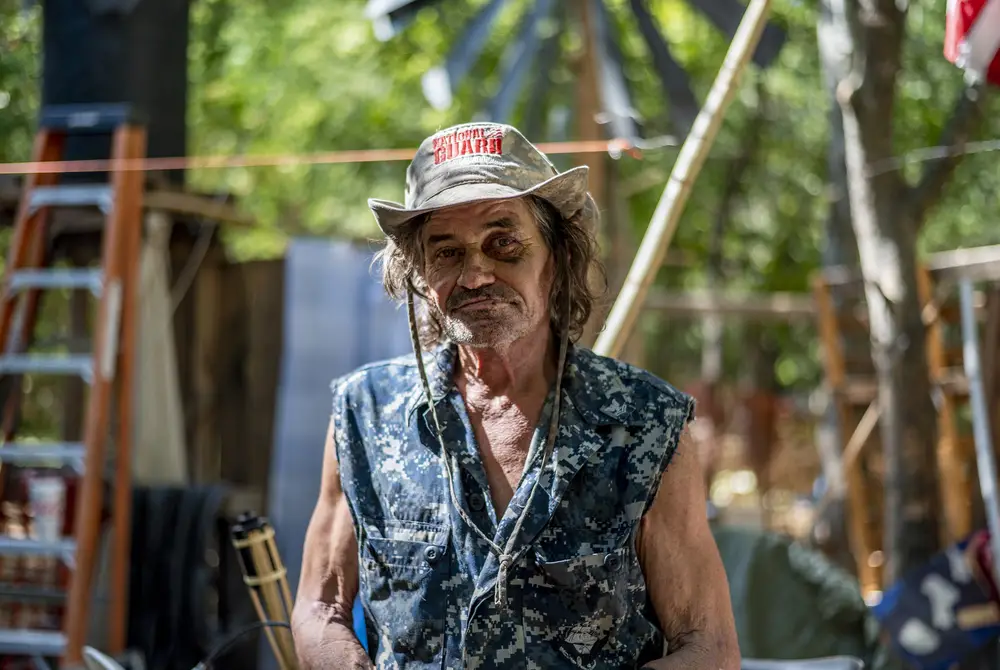
Steve at his living space in the Guerrero Park encampment. He visited Aug. 18 to collect some of his belongings after being given a room in a former hotel that the city converted into a temporary shelter. Credit: Sergio Flores for The Texas Tribune
Steve, who is 67 and did not give his full name, said he has lived in Austin for 40 years and used to run a tire business. But housing had become unaffordable for him, and a couple of years ago “things fell apart,” he said, and he wound up homeless.
He had been moved out of several encampments and was ticketed by police for violating the camping ban before he was connected to a room in a bridge shelter through HEAL while camping in the park.
“I really want to get permanent housing,” he said, standing at the front of his camp, where he had returned to collect some belongings he left behind. “Then I’ll be happy again that I can still stay in Austin and get a part-time job.”
The two tents beside his sat empty — his neighbors had also just moved into bridge shelters. Soon the camp would be cleared entirely.
“There shouldn’t be too many people out here, shortly,” he said. The HEAL team, he said, is “doing a good job. It’s impressive.”
Near Steve’s camp, a small group of people sat on couches and chairs under tarps, shielded from the sun. With no more rooms available at the bridge shelters, they would have to leave the park soon.
“We’ll just move to another campsite until they put us on the list,” one woman said, a puppy sleeping on the couch beside her. She didn’t know where they’d go.
“Anywhere but here.”
Lucy Tompkins works for the Tribune as a housing and homelessness reporting fellow through The New York Times’ Headway Initiative , which is funded through grants from the Ford Foundation, the William and Flora Hewlett Foundation and the Stavros Niarchos Foundation (SNF), with Rockefeller Philanthropy Advisors serving as a fiscal sponsor.







